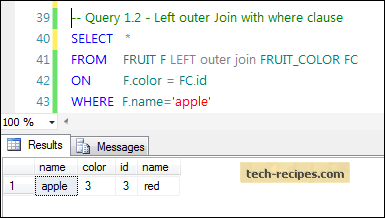LEFT JOIN gets all records from the LEFT linked table but if you have selected some columns from the RIGHT table, if there is no related records, these columns will contain NULL. RIGHT JOIN is like the above but gets all records in the RIGHT table. LINQ Inner-Join vs Left-Join - Stack. A left outer join will return all the data in Table and all the shared data (so, the inner part of the Venn diagram example), but only corresponding data from Table which is the right join. INNER JOIN vs LEFT JOIN performance in SQL Server.
In a left join, these rows are included in the result set with a NULL in the Quantity column. In case of no match with right side table it will return NULL value. Left Join ” and “ Left Outer Join ” are used interchangeably because records which are returned will be the same with either of these. What is the difference between inner join and outer join ? Left outer join returns all rows of table on left side of join. The rows for which there is no matching row on right side, result contains NULL in the right side.
Inner join shows only where there is a key match in both tables. Left join shows everything from table and will show blanks in the tablefields if there is no matching row. SAS has quite a few different options for this. Self join is not a keyword in SQL, when a table references data in itself knows as self join.

You can also use LEFT OUTER JOIN or RIGHT OUTER JOIN , in which case the word OUTER is optional, or you can specify CROSS JOIN. By using the merge function and its optional parameters:. The will be identical to inner join if there is a relevant row for every table1. There is a notable difference where left join and left outer join used when using Microsoft SQL server.
All in all, use of the left join or left outer join statement refers to the exact same statement. Since there is no difference, the use of the left outer join is recommended. It be good to think back on the old ways, since the names arrive from long forgotten history.
That would give you all rows that ma. The SQLite LEFT JOIN joins two tables and fetches rows based on a condition, which is matching in both the tables and the unmatched rows will also be available from the table written before the JOIN clause. So, in case of LEFT JOIN or LEFT OUTER JOIN , SQLite - 1. What Is the Difference Between a Join and UNION? Joins and Unions can be used to combine data from one or more tables.
The difference lies in how the data is combined. In simple terms, joins combine data into new columns. If two tables are joined together, then the data from the first table is shown in one set of column alongside the second. An inner join is used to return by combining rows from two or more tables. In its simplest case, where there is no join condition, an inner join would combine all rows from one table with those from another.
In this communication driven worl we obviously need to handle data in an efficient manner as communication is all about data transmission. To do this, we have databases such as MS Access, SQL Server, Oracle, etc to store and retrieve our data for our day-to-day purposes. So Table_A is our left table as it appears to left of Left Outer Join operation and Table_B is our right table.
Initially, the inner join would be applied on Table_A and Table_B which will return all the matching tuple from table A and B. This keyword will create the result-set by combining all rows from both the tables where the condition satisfies i. Which join is better performing if all of them provides the same result? I addition of the previous answer, for what I know, MySQL is optimized to have the same performance. Optimization vs Human Reading take sense on large queries with lot of joins. Learn about the LEFT OUTER JOIN vs.
RIGHT OUTER JOIN in SQL , see examples of SQL joins and find tips for working with multiple tables as part of clauses in this excerpt from a book on writing SQL queries. They produce the same result and also the same performance. When dealing with SQL, joins is a common name that will pop up every now and then. The join clause helps in the combination of records from different tables in a data set.
ID means show only records where the same ID value exists in both tables. LEFT JOIN is same as LEFT OUTER JOIN and means to show all records from left table (i.e. the one that precedes in SQL statement) regardless of the existance of matching records in the right table.
Geen opmerkingen:
Een reactie posten
Opmerking: Alleen leden van deze blog kunnen een reactie posten.